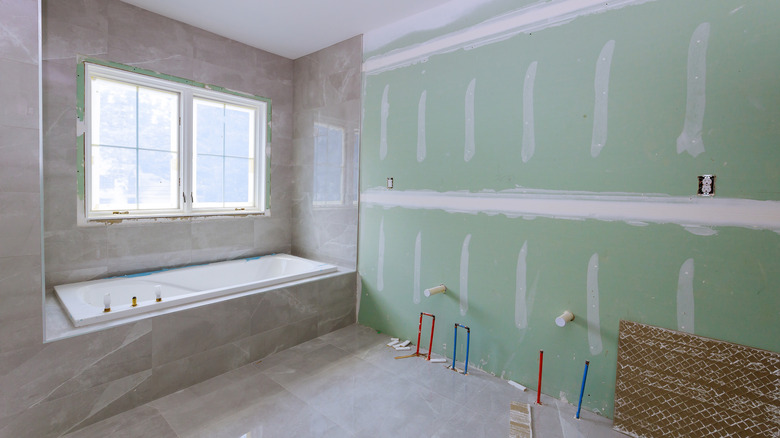Can You Reuse Drywall From Your Bathroom Remodel?
Bathroom remodels are among the most costly renovations you can undertake. Between the extra precision needed for pipe work, the requirement of moisture resistant materials, and the specialty fixtures, you're likely looking at a total bill well in the thousands. There are however a number of ways to cut the cost of your bathroom remodel, including doing parts of the work yourself and even repurposing some of the original materials. When it comes to the drywall, the answer of whether you can reuse it is not a definitive yes or no — the answer is more along the lines of 'it depends.'
Unless you know for a fact your bathroom walls were made with water or mold resistant materials, there's a chance your current drywall could be contaminated. You'll need to pay particular attention to the condition of the drywall around the shower, bathtub, sink, and toilet as those areas have the highest probability of mold or moisture. If you notice any signs of deterioration, even the smallest of spots, that drywall needs to be discarded — you don't want to begin your remodel with materials that are already starting to fail.
Checking the drywall for damage
If you're planning a big remodel with a revamped layout, you'll most likely have to remove some drywall. In most demolitions, that process begins with swinging sledgehammers. That won't fly if you plan to reuse it, and, in reality, it's incredibly difficult to remove the drywall with enough precision to keep it intact for a second use.
If you can avoid moving walls, the first and most important step in determining if your drywall is good to go for another round is checking it carefully for water or mold damage. Any discoloration should be obvious, but stains are not the only signs. In fact, some mold may be so light in color that you don't notice it. This is where your touch and smell come into play. A section of drywall that's damaged with moisture will likely have a soft texture, and you may notice parts of it are peeling or bubbling. An area with mold growth will feel almost like slippery grease, and it'll streak if swiped over. Mold also carries a distinct musty odor.
Any sections of the drywall that show cracks, bumps, or tears may need to be taken out, too. This type of damage is like an open door for water to seep through, set up camp, and begin sprouting mold. Successful repairs are possible if the damaged area is relatively small and shallow. Anything beyond that should be subject to replacement.
The best drywall for your bathroom
If signs of mold and water damage are discovered or a large repair is needed, it's best to start fresh with a new panel. You don't necessarily have to trash the old. You can repurpose the good parts in smaller projects and other areas of the home or simply recycle it.
When you need to place new drywall in your bathroom, go for the moisture and mold resistant varieties to minimize future issues. There are several options to choose from, including green, purple, and blue board drywall or fiberglass drywall, also known as paperless. You could also skip the drywall altogether and go with cement boarding. Each of these options have their own pros and cons, and all offer different levels of moisture and mold protection. You'll want to consider carefully which areas of your bathroom remodel need drywall then consult your budget to determine which option is best for you.


